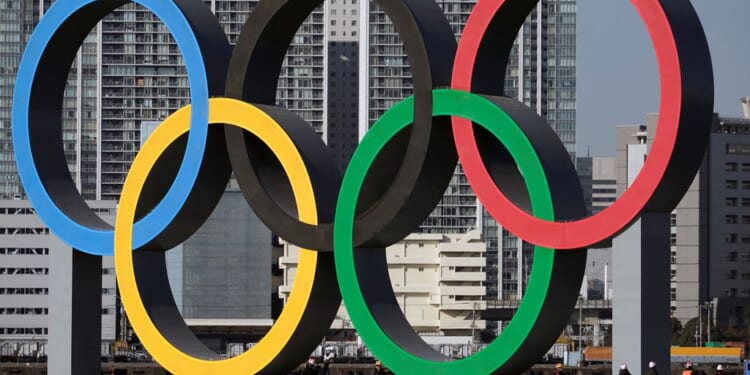The study of science has fallen on hard times over the past decade, as activists from all causes have twisted data and studies to advance their particular agendas. No offender has been worse than the transgender movement, though, which has outright ignored science and even the simple eye test to argue that there are no differences between men and women. The fragile faux science of transgenderism is now beginning to crumble, with skepticism reaching the Olympic stage.
The International Olympic Committee is on the verge of banning “transgender women” (read: men) from women’s competitions. Leaks from an IOC meeting detail a scientific breakdown of the physical advantages men’s bodies have compared to women, presented by the IOC’s medical and scientific director. One source described it as “a very scientific, factual and unemotional presentation which quite clearly laid out the evidence.” The report even delved into the advantages for athletes suffering from Disorders of Sexual Development, a collection of different (rare) genetic sexual disorders, when compared to female athletes.
TITLE IX ACTIVIST PREDICTS GENETIC SCREENING ‘IS THE FUTURE OF WOMEN’S SPORTS’
The IOC publicly claims it has not made a decision, but the committee is reportedly going to announce the ban early next year, given that activist backlash doesn’t pressure it into reversing course.
It would be welcome news for the IOC to have come around to the scientific reality that men have biological strength and speed advantages over women. It would also be late, given that World Rugby dropped a 38-page report on those biological advantages back in 2020. World Rugby’s study of its own sport found that a female rugby player tackled by a biological man would have a 20%-30% higher chance of being injured than if they were tackled by a female rugby player. The study found men to be 25%-50% stronger, 30% more powerful, 40% heavier, and 15% faster than their female counterparts.
But the reality is that neither the IOC nor World Rugby ever needed a study or a scientific breakdown to determine that men and women are fundamentally different. The Olympics first allowed women to compete in 1900, and immediately began separating men’s and women’s competitions. The Olympics to this day have separate men’s and women’s competitions, which is inconsistent with the assertion by transgender activists that men and women are not biologically different and that men can become women by claiming to be so. Follow the “logic” of transgenderism to its end, and there is no reason for men’s and women’s sports to be separated at all.
You could see the differences if you happened to watch some of the few Olympic events that allowed men to compete. For example, Laurel Hubbard is a New Zealand man who began calling himself a woman at the age of 35. Despite this, he was allowed to participate in women’s weightlifting, qualifying for the 2020 Tokyo Olympics at the age of 43, which is not what you would consider the athletic prime of an Olympic weightlifter. Hubbard’s qualification meant that a real woman, 21-year-old Kuinini Manumua of Tonga, was blocked from qualifying for her first Olympic Games.
Hubbard’s qualification is more absurd when you look at the women he was competing against. Relying on a lifetime of testosterone and the advantages of male biology, Hubbard was a 43-year-old competing against women in their athletic prime. At the 2019 World Weightlifting Championships, the oldest woman to medal in Hubbard’s division was 30 years old.
Moreover, a look at the biological differences between men and women in different weight classes in the sport showcases how ridiculous this debate ever was. China’s Li Wenwen set two new world records in the superheavyweight division (191+ pounds). Li herself is listed at 331 pounds. At those very same championships, both of her world record lifts were beaten by men in the third-lightest division, which is limited to men who weigh less than 148 pounds.
Take a look at some other sports differences and you find the same wide disparities, even with the best female athletes in history. The women’s world record in the 100-meter dash is 10.49 seconds, a record that has stood since 1988. That time is regularly beaten by the top high school boys sprinters in the country. The same is true for (but not limited to) the following distances: 200m, 400m, 800m, 1500m, and 1600m. You could have watched all 26 games of women’s basketball at the 2024 Paris Olympics and not seen anyone from the 12 different countries represented dunk a basketball, while the men’s side has a seven-minute compilation of just the “best dunks.”
If anyone should have been able to recognize that allowing biological men to claim to be women and compete against women would be unfair, it would be the people who run the Olympics. Still, the fact that the IOC may indeed be going ahead with limiting women’s sports to biological women is a welcome piece of news, especially given that the analysis of people with Disorders of Sexual Development was also discussed as a concern.
That became a prevalent issue at the 2024 Olympics, when Algeria’s Imane Khelif and Taiwan’s Lin Yu-ting dominated the welterweight and featherweight divisions. Both Khelif and Lin were previously disqualified from the Women’s World Boxing Championships by the International Boxing Association after failing genetic tests. Lin declined to appeal the disqualification, and Khelif withdrew his appeal, because that would allow the results of those tests to eventually be made public. Both claimed to be women, so that would be unacceptable.
They both cruised to gold medals in their respective categories, with Khelif’s brutal beating of Italian Angela Carini being the lasting image of boxing at the 2024 Olympics. While we do not know exactly what the story is for Khelif or Lin, the most likely explanation is that both suffer from some form of DSD. Khelif notably tried to get the genetic testing requirement thrown out for the 2025 World Boxing Championships and ended up not participating as those requirements remained in place. If the story were as open and shut as “Khelif is a woman,” then “she” wouldn’t be fighting so hard to keep those genetic testing results so private.
THE MENTAL GYMNASTICS OF SIMONE BILES
We had seen what happens when someone with DSD competes against women in the Olympics with Caster Semenya, the South African runner who won gold in 2012 and 2016. Semenya is genetically male but was raised as a girl due to having the 46 XY disorder of sexual development, which results in ambiguous genitalia. Semenya was blocked from competing in the 2020 Olympics as a result, because the IOC at the time allowed different sports governing bodies to set their own rules for eligibility. Carini and other female boxers likely wished their governing body cared about their safety as much as World Athletics cared about the integrity of track and field.
The IOC has a chance to rectify that and apply universal standards to all Olympic sports, if it indeed follows through by limiting women’s sports to biological women with women’s genetics. The answer was staring the IOC in the face all this time, every time runners took off from the starting blocks, Hubbard lifted a bar, or Khelif punched a woman in the face. The science always pointed to the same answer, and the IOC has a chance to bring some respect back to the discipline after transgender activists have done so much to corrupt it.















